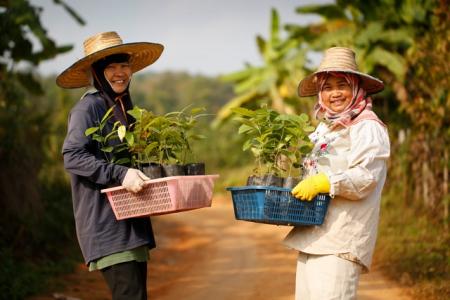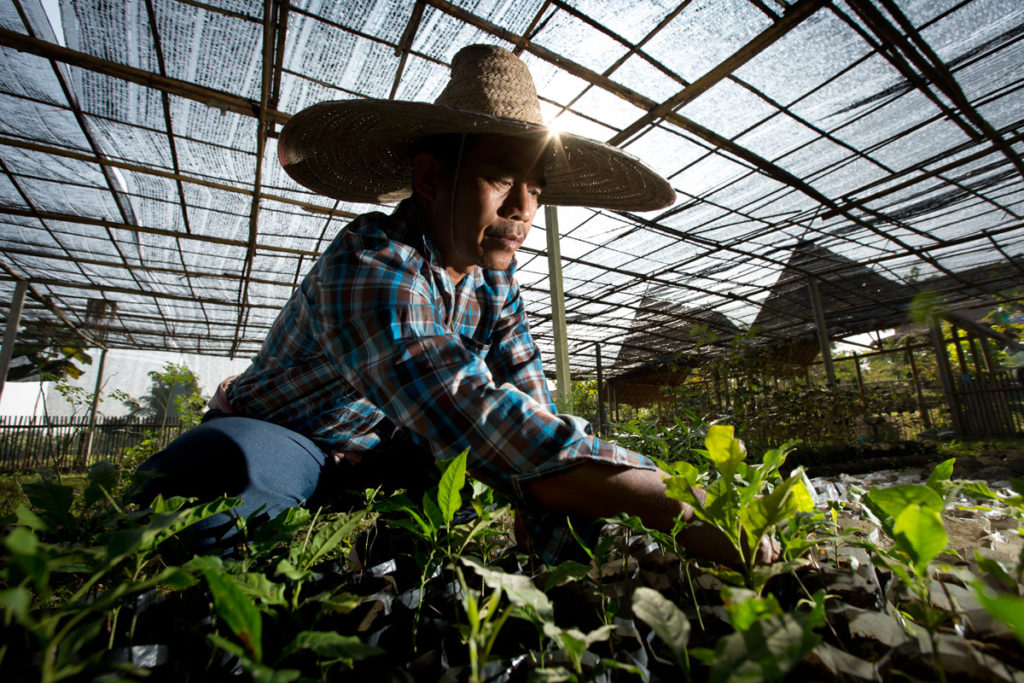Carbon finance has become a hot topic in rural development, with many governments and civil-society groups looking to leverage the carbon capture potential of trees and soil to raise funds for agricultural and agroforestry projects. But as my colleagues have noted, carbon finance can also be problematic, if it limits how farmers can use their land to grow food and cash crops.Is there a way to avoid that conflict? In a panel discussion at the World Congress on Agroforestry last month, Tristan Lecomte, founder and CEO of Pur Projet, described an interesting approach that he has been taking with clients such as Louis Vuitton, Chanel, Hugo Boss, Marks & Spencer and Guerlan. He calls it “insetting” – building carbon offset production into business relationships with farmers. We talked afterward about how the concept came about, and how it has worked.
Lecomte started his work in the environmental sector in 1998 with the fair trade company Alter Eco,, which sources organic foods from South America for sale in Europe, the U.S. and Australia.
“Alter Eco has become the main fair trade brand in France, and people started to ask what we do to offset our carbon footprint,” Lecomte told me. ”We started to buy offsets, like solar panels in Bolivia, but it was unconvincing. So, we started to plant trees within the cocoa farms that we were buying cocoa from, and we found out that it combines very well and is able to create even more revenues for farmers than fair trade.”
“The problem with fair trade”, he added, “is that it is highly competitive, and you cannot pay a lot to farmers – otherwise your product will be too expensive for consumers. And so I thought that planting trees on farms to offset carbon is a great innovation that can help farmers to diversify their incomes, increase yields and grow cocoa with more complex taste.”
Lecomte went on to start Pur Projet to offer his model of agroforestry and carbon credits to other companies. The practice is called “insetting” to emphasize that rather than being a separate, external activity, offsetting is being done within the supply chain of the company that wants to reduce its carbon footprint.
“The more you do within your business, the better it is integrated and the more it has chance to be perennial,” Lecomte explained. “If your company is in France and you do carbon offsets in farms outside of your supply chain in Mozambique, the chances to cut carbon offsetting expenditure in times of financial difficulties are very high. It also answers the ‘guilt-free’ critiques on the entire concept of offsetting.”
Another interesting aspect of the approach is that Lecomte doesn’t present “insetting” as strictly a corporate social responsibility (CSR) measure, but as a smart business practice.
“First we meet with the company and ask them about their problem,” he said. “If you work in Louis Vuitton, saving the world is not your highest priority. What you are interested in is a good product.” One of Louis Vuitton’s priorities is to procure high-quality leather, Lecomte noted, “and to get such leather it is important for a cow to have good food and not to be stressed by the sun. The solution is to plant trees on pastures that will provide shade and help to improve soil to grow better grass.”
That, in short, is the business case for investing in agroforestry: “Planting trees within their own supply chain means securing their net profit in the long run, because if the ecosystem that they extract their resources from will come to an end, there will be no more resources for their business.”
 Photo from Pur Projet’s work in Thailand,courtesy of Christian Lamontagne
Photo from Pur Projet’s work in Thailand,courtesy of Christian Lamontagne
But what about the farmers? What benefits does this approach bring for them?
Lecomte explained that every project begins by working with a local NGO to assess local ecosystems and identify farmers who are a good fit for the project. Then they do a three-year trial. “Then if both sides are satisfied, we make a project for carbon offsetting for 40 years, but usually the results are already visible within the initial step.”
The long-term projects usually involve well-running farmers’ cooperatives, to guarantee a larger number of offsets for big companies and to reduce administrative burdens. “There are exceptions, for example on projects in Guatemala where we work with groups of farmers. In all cases we hire people from within the cooperatives.”
Lecomte also noted that the carbon credits produced by Pur Projet are not traded, but rather used by the company involved in the project. This greatly reduces transaction costs, and as a result farmers receive at least 70% of the value of the offsets produced. Still, a lot of these efforts fail. Lecomte said a 50% failure rate is normal in the first, trial phase of a project, when several thousand trees are planted; one project in Thailand had a 65% failure after the area was flooded for three months.
Along with weather, common factors that lead projects to fail include limited capacity among farmers – for example, if they are too busy tending their main crops – and political conflicts and crises. Lecomte is not discouraged, however: “I prefer to give trees and fail, than to make a very complicated study and then still have failure after the trees are planted”.
It is difficult to know how viable carbon finance will turn out to be for agroforestry, but to the extent that projects like these put more trees on farms, they may still be worthwhile. Trees can provide timber, food and medicine, support livelihoods, and shelter people and animals from the hot sun, and these benefits can outweigh the value of carbon credits.
Ekaterina Bessonova is a communications assistant for the Swedish International Agricultural Network Initiative (SIANI). She attended the World Congress on Agroforestry as part of collaboration between SIANI and the Forest, Climate & Livelihood Research Network (Focali) around the theme “Forests, Landscapes and Food Security”.
Can Carbon Finance Take Small-scale Agroforestry to The Next Level?
SIANI at the World Congress on Agroforestry: Focus on trees and food security
